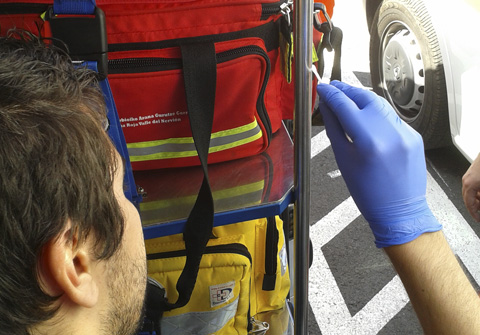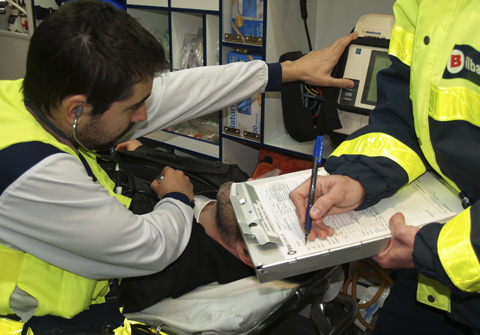A multidisciplinary UPV/EHU team has spotted shortcomings in the procedures designed to reduce the bacterial contamination of ambulances, which could affect the people being carried. According to the research published in the American Journal of Infection Control, the location of the most conflictive points in ambulances points to the need to draw up programmes to raise awareness, educate and promote safe practices (such as hand washing) that will optimize the hygiene of the personnel and the cleanliness and disinfection of the medical vehicle.
Ambulances could pose an infection risk
A study by the UPV/EHU-University of the Basque Country warns of the need to draw up disinfection protocols and raise awareness among healthcare staff about hygiene
First publication date: 16/09/2016

Ambulances can be a source of microorganisms that cause or develop diseases that can be transmitted to patients or healthcare personnel. These pathogenic organisms are sometimes resistant to a whole host of drugs; and the hands are the main cause of transmission. A team of professionals drawn from Nursing, Medicine, and Biology —coordinated by the professor of Microbiology and lead researcher Guillermo Quindós— carried out a cross-sectional study to analyse microbe or bacteria contamination in ambulances. This is the first time that a piece of research of this type targeting basic life support vehicles has been carried out in our country.
The samples were collected in July 2012 in 10 of the 17 basic life support ambulances serving greater Bilbao. The medical vehicles had been called out on average 225 times during the 30 days previous to the microbiological study. The university team used blind masking techniques so as not to alter the usual conditions of the vehicles and prevent possible biases in the sample collecting, analysis and interpretation.
During the sample gathering, not one of the ten emergency units was found to have a wash hand basin (although it is not obligatory) for hand washing, although eight of them were carrying a hydroalcoholic gel as a substitute for soap and water. It was also seen that they did not have any written protocol regarding the way the ambulance should be cleaned and disinfected. "The existence of a protocol is desirable because it facilitates the carrying out of proper disinfection by stipulating in detail the steps to be taken," pointed out Guillermo Quindós, professor of Microbiology at the UPV/EHU.
Six points were analysed in each ambulance: two in the driver's cab and four in the patient area. In 73% of the 60 samples taken there was a greater presence of microbes on the steering wheel, on the inside handle of the passenger door and on the stretcher handles. These data suggest that cross contamination exists between the patient area and the driver's cab caused by inappropriate habits such as, for example, driving with gloved hands after providing assistance or failure to wash one's hands. The lead researcher Guillermo Quindós highlighted the fact that "among the people working in healthcare the hand washing habit is poor and it would be necessary to build awareness about the importance of this hygiene measure to prevent microbial contamination".
After analysing the different samples, the UPV/EHU team detected the existence of Staphylococcus aureus, coagulase negative staphylococcus and other gram-positive cocci, enterobacteria and other gram-negative bacilli which despite not reaching alarming levels did warn of the possibility of cross contamination between the interior and exterior space of the hospital through the transfers carried out using ambulances. Even so, the levels of contamination found in the medical vehicles were low; in fact only in two ambulances did they find three cultures of Staphyloccocus aureus. These are more aggressive infectious agents, which, despite having the potential of being present in healthy individuals, are responsible for hospital infections, above all in sick people. A significant finding was that the microbial contamination of the ambulances in Greater Bilbao was much lower than that found in similar studies carried out in the United States.
Bibliographic reference
- Detection and characterization of surface microbial contamination in emergency ambulances
- American Journal of Infection Control (2016)
- DOI: 10.1016/j.ajic.2016.05.024



